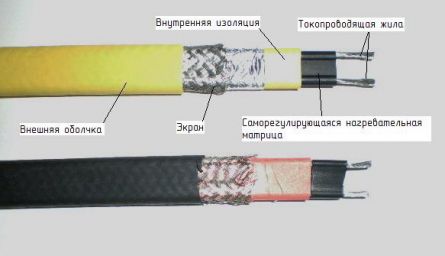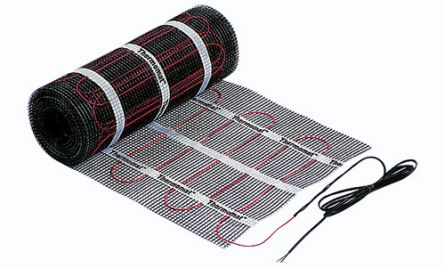An alternative or effective addition to heating radiators, installed along the walls under the windows, is a warm floor. Modern technologies offer different types of equipment for its device. To make the right choice and installation of such a heating system, you need to know the warm-alone device, the advantages and disadvantages of all its species.
Content
- On the benefits of heated floors
- Differences between electrical and water systems
- Features of the installation of electric heating floor of different types
- Advantages of electric heating floor
- Disadvantages of electric heating floor
- Cables for electric heating floor
- Water floors
- Varieties of water warm floor
- Dignity of water warm floor
- Disadvantages of the water heating system
On the benefits of heated floors
- In contrast to traditional radiators, fixed on the walls, the movement of heated air directed up (according to the laws of physics) affects the lower areas of the room. Thus, the entire volume of the room is uniformly. It clearly demonstrates the following illustration.

- A person feels warm feet feet, which allows you to correctly evaluate the microclimate in the room and save fuel (electricity).
- The best warm floors make it possible to automatically adjust the temperature using special equipment. This saves thermal energy.
- The surface emitting heat in the case of the use of warm floors will be much greater than the area of \u200b\u200bradiators. It also increases the efficiency of the system.
- With the help of a warm floor, you can additionally warm up the most problematic areas in the house: bedside zones, children's rooms, sites near the bath or shower, loggia and balconies.
- Heating floor heating elements are hidden, which is a more winning option from aesthetic point of view.
- Warm floors are safe for children: there are no radiators from which it is possible to get a burn with a random touch.
Differences between electrical and water systems
The warm floor can be arranged with pipes, which flows the coolant (usually water) or created on the basis of electrical cables.
The main elements by which the warm floor of water is mounted are:
- heating boiler (gas, solid fuel, working on liquid fuel or electric);
- input and output collectors (distribution and adjustment system);

- water pipes for transporting the coolant (most often heated to a given water temperature);
- device for manual or automatic temperature adjustment (complete with thermal sensors and control panels);
- pOMP (circulating pump).
Electric warm floor can be created based on:
- electric heating cables;
- electric heating mats;
- infrared film heaters.
The selection of the heating system depends on the availability of a particular type of fuel, the preparedness stage of the building, the features of the floor device and the housing type (apartment in a high-rise building or cottage). Water warm floor is cheaper in operation and cost-effective electrical, but its installation is possible only at the construction stage and only in a private house (cottage). The device of such heating in a multi-storey building is likely to be prohibited by the corresponding instances at the coordination stage. Electric warm floors are usually used as an additional.
Features of the installation of electric heating floor of different types
Such heating depends on the electrical networks of the house and cannot be arranged with a different source of thermal energy. When installing such a system, the following nuances should be taken into account.
- Laying cables and mats in the furniture installation zone is invalid: this leads to a violation of natural convection and overheating of cables. As a result, the conductors burn out. To avoid local overheating and output of the system, it is necessary during its installation to take into account the future layout of the room. Move furniture after installation is also impossible.
- Temperature sensors of the automated control system must be placed where there are no carpets. The thermostat panel is attached to the wall in an accessible place.
- For floors of natural wood (parquet, parquet board), heating based on electrical cables and mats is not suitable: wood should not be heated above 30-32 ° C, otherwise the material will crack and brew. In this case, the film warm floor will be more gentle.

- Heating cables and mats are recommended to stallets under porcelain stoneware or ceramic tiles: these materials are not subject to temperature expansion.
- When using a geepboard or parquet, wood should be carefully dried: it will prevent its warping. It is necessary to use heat-resistant glue for the installation of linoleum, carpet or parquet.
- High-pile tube and carpet flooring for flooring is not recommended: their high thermal insulation properties reduce the effectiveness of the heating system.
- The electrical cable creates an electromagnetic field around itself, so such heating is unsafe for humans. An alternative can be infrared warm floor: its principle of operation eliminates the occurrence of electromagnetic induction.
- When damaged the cable, it is necessary to accurately set the place of damage to mount the coupling. Otherwise, you will have to change a whole area or the entire system.
- Installation of the film floor does not reduce the height of the ceilings (unlike cable systems laid under the layer of screed), which means the installation can be made in the buildings of the old building.
- In case of damage to the insulation of the conductor from electric shock, it will protect the RCD (protective shutdown), which is necessarily installed in the area of \u200b\u200bthe power cable in the dwelling.
- In order for the heating with the help of electricity to be more economical, the installation of a multi-tariff electricity meter is necessary.
Advantages of electric heating floor
- Optimal temperature distribution throughout the size of the room. Maintain a predetermined temperature can be with very high accuracy. When using local heating, the selected area will have the same characteristics as in the case of the application of this system as the main one.
- Electrical systems, compared with water, are practically devoid of inertia. Heating and cooling of the floor surface occurs in just a few minutes.
- The service life exceeds 50 years, subject to compliance with the rules for installation and operation.
- Installation is possible on top of the old flooring.
- Comparative cheapness and ease of installation work.
About how the electric warm floor is mounted, you will learn by reviewing the video.
Disadvantages of electric heating floor
1. High power consumption. This imposes restrictions on the use of such a type of heating, especially in areas with low power grid and in the houses of the old building (with poor thermal insulation).
2. The presence of electromagnetic radiation (except for film floors).
3. Strong heating of the floor covering can lead to some of the materials. This limits the choice of materials when choosing a way to finish the room.
Cables for electric heating floor
- Heating cables of resistive type: conductor of such cables made of metal with high electrical resistance (most often from nichrome). This allows you to obtain a large amount of thermal energy when the electric current is passed. It is single and twilient: the latter simplifies the installation, since there is no need to connect both ends to the thermostat.

- Camers regulating cables: thanks to a special device, they are not afraid of local overheating. The role of the heating element performs a polymer matrix that responds to a local increase in temperature with a decrease in conduction. Their disadvantage is high cost.

- Heating mats are small cross-section cables, laid in the form of a snake on a polymer grid. Such mats are easy to install, but not indoors with complex geometry.
Water floors
The warm floor of this system can be part of a centralized heating system, but only in new buildings and in the presence of permission of relevant instances. Water warm floor can be adapted to any type of fuel (in accordance with the heating device).
Varieties of water warm floor
Warm water floor can be arranged from polyethylene and metal-plastic pipes. The latter are more efficient, due to the high level of heat transfer. Polyethylene - more dense, they have a long service life. These materials are not afraid of corrosion and are anti-acid, which is important for the safe operation of the boiler.
Water warm floor is mounted dry and wet method. The latter provides for the pouring of the pipes with a concrete screed, and with dry installation, aluminum plates and water-absorbing gaskets under the finish coating are used.
Dignity of water warm floor
In addition to those advantages that electric warm floors have, this system is characterized by:
- low power consumption: it is spent only to ensure the operation of the circulation pump;
- lack of danger of human damage by electric shock and the harmful effects of electromagnetic radiation;
- the possibility of using for any type of flooring, due to the lower temperature of the coolant.
Disadvantages of the water heating system
- Complexity and high cost of installation work.
- Inertia of the heating system: the heating of the floor surface takes a long time.
- The need for additional protection of pipes from damage.
- The impossibility of mounting in multi-storey houses of an old type.
- Smaller, compared with electrical systems, service life.
The following information will help make the right selection of the heating system. In conclusion, the video demonstrating the process of laying a water warm floor.






















